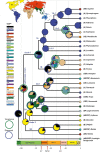A comprehensive genus-level phylogeny and biogeographical history of the Lythraceae based on whole plastome sequences
- PMID: 37439499
- PMCID: PMC10583215
- DOI: 10.1093/aob/mcad091
A comprehensive genus-level phylogeny and biogeographical history of the Lythraceae based on whole plastome sequences
Abstract
Background and aims: The Lythraceae are a mainly subtropical to tropical family of the order Myrtales with 28 currently accepted genera and approximately 600 species. There is currently no well-supported phylogenetic and biogeographical hypothesis of the Lythraceae incorporating all currently accepted genera, which we sought to provide.
Methods: Plastomes of representative species of 18 distinct Lythraceae genera were sequenced and annotated. Together with existing sequences, plastomes of all 28 currently accepted genera in the Lythraceae were brought together for the first time. The plastomes were aligned and a Bayesian phylogenetic hypothesis was produced. We then conducted a time-calibrated Bayesian analysis and a biogeographical analysis.
Key results: Plastome-based Bayesian and maximum-likelihood phylogenetic trees are generally congruent with recent nuclear phylogenomic data and resolve two deeply branching major clades in the Lythraceae. One major clade concentrates shrubby and arboreal South American and African genera that inhabit seasonally dry environments, with larger, often winged seeds, adapted to dispersal by the wind. The second major clade concentrates North American, Asian, African and several near-cosmopolitan herbaceous, shrubby and arboreal genera, often inhabiting humid or aquatic environments, with smaller seeds possessing structures that facilitate dispersal by water.
Conclusions: We hypothesize that the Lythraceae dispersed early in the Late Cretaceous from South American to North American continents, with subsequent expansion in the Late Cretaceous of a North American lineage through Laurasia to Africa via a boreotropical route. Two later expansions of South American clades to Africa in the Palaeocene and Eocene, respectively, are also hypothesized. Transoceanic dispersal in the family is possibly facilitated by adaptations to aquatic environments that are common to many extant genera of the Lythraceae, where long-distance dispersal and vicariance may be invoked to explain several remarkable disjunct distributions in Lythraceae clades.
Keywords: Lythraceae; biogeography; dispersal; phylogeny; plastome.
© The Author(s) 2023. Published by Oxford University Press on behalf of the Annals of Botany Company. All rights reserved. For permissions, please e-mail: journals.permissions@oup.com.
Figures












Similar articles
-
A dated molecular phylogeny and biogeographical analysis reveals the evolutionary history of the trans-pacifically disjunct tropical tree genus Ormosia (Fabaceae).Mol Phylogenet Evol. 2022 Jan;166:107329. doi: 10.1016/j.ympev.2021.107329. Epub 2021 Oct 19. Mol Phylogenet Evol. 2022. PMID: 34678410
-
Post-Boreotropical dispersals explain the pantropical disjunction in Paederia (Rubiaceae).Ann Bot. 2013 May;111(5):873-86. doi: 10.1093/aob/mct053. Epub 2013 Mar 10. Ann Bot. 2013. PMID: 23478944 Free PMC article.
-
Out of southern Africa: Origin, biogeography and age of the Aizooideae (Aizoaceae).Mol Phylogenet Evol. 2017 Apr;109:203-216. doi: 10.1016/j.ympev.2016.12.016. Epub 2016 Dec 18. Mol Phylogenet Evol. 2017. PMID: 27998816
-
Plastid phylogenomics and biogeographic analysis support a trans-Tethyan origin and rapid early radiation of Cornales in the Mid-Cretaceous.Mol Phylogenet Evol. 2019 Nov;140:106601. doi: 10.1016/j.ympev.2019.106601. Epub 2019 Aug 21. Mol Phylogenet Evol. 2019. PMID: 31445202
-
Vicariance and dispersal in southern hemisphere freshwater fish clades: a palaeontological perspective.Biol Rev Camb Philos Soc. 2019 Apr;94(2):662-699. doi: 10.1111/brv.12473. Epub 2018 Oct 19. Biol Rev Camb Philos Soc. 2019. PMID: 30338909 Review.
References
-
- Ali JR, Hedges SB.. 2022. A review of geological evidence bearing on proposed Cenozoic land connections between Madagascar and Africa and its relevance to biogeography. Earth-Science Reviews 232: 104103. doi: 10.1016/j.earscirev.2022.104103. - DOI
-
- Awasthi N. 1968. A fossil wood of Sonneratia from the Tertiary of South India. Palaeobotanist 17: 254–257. doi: 10.54991/jop.1968.800. - DOI
MeSH terms
LinkOut - more resources
Full Text Sources
Research Materials

